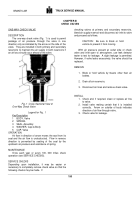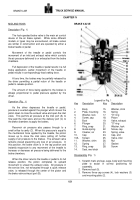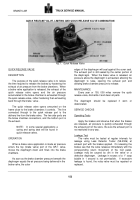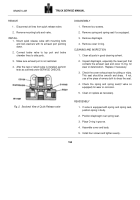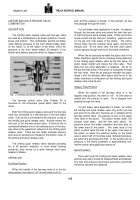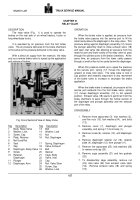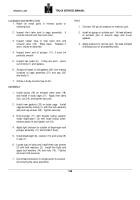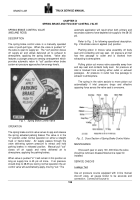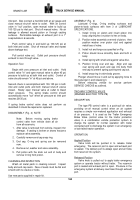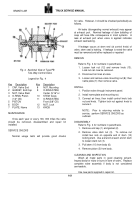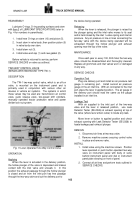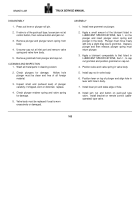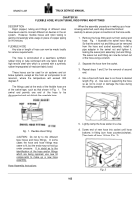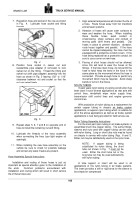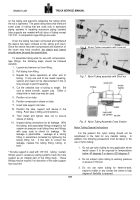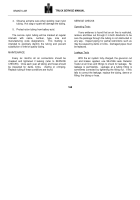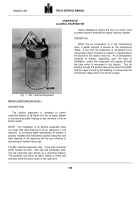TM-5-3805-254-14-P-2 - Page 162 of 894
TRUCK SERVICE MANUAL
inlet port.
Also connect a manifold with an air gauge and
close manual shut-off valve to outlet.
With air control
valve in "out" position, open manual valve to build up
100-125 psi to inlet port.
Shut off manual valve.
No air
leakage is allowed around piston or through casting
surfaces.
Permissible leakage at exhaust port is a 1"
soap bubble in 6 seconds.
Push control valve in and build up 100-125 psi at
both inlet and outlet.
Shut off manual valve and repeat
above leakage test.
Pull control valve out.
Outlet port pressure should
exhaust to zero through valve.
Operation Test
Begin with zero pressure at inlet and outlet.
Hold
control valve "in" and open manual valve to allow 45 psi
pressure to build up at both inlet and outlet.
Control of
valve should remain "in" at 45 psi and above.
Second check is accomplished with 100-125 psi in both
inlet and outlet ports and both manual shut-off valves
closed.
Slowly open manual valve at outlet to bleed
down pressure.
The spring brake control should
automatically move "out" when air pressure at inlet port
reaches 28-35 psi.
If spring brake control valve does not perform as
described it should be repaired or replaced.
DISASSEMBLY (Fig.
2)
NOTE
Note:
Before moving spring brake
control valve from vehicle drain all air
from all reservoirs,
1. After valve is removed from vehicle, inspect it for
damage.
If casting is broken or shows fractures
replace valve assembly.
2. Carefully remove end cap snap ring.
3. End cap, O-ring and spring can be removed
now.
4. Remove nut, washer and valve assembly.
5. Pull piston with the knob out end of body and
remove O-ring from piston.
CLEANING AND INSPECTION
Wash all metal parts in cleaning solvent.
Inspect
body and end cap seats.
Face of seats must be flat and
smooth with no cracks or nicks.
Use new parts supplied in repair kit.
ASSEMBLY (Fig.
2)
Lubricate O-rings, O-ring sealing surfaces and
piston-to-body surfaces with Item 3 of LUBRICANT
SPECIFICATIONS.
1. Install O-ring on piston and insert piston into
body, aligning hex on piston to hex on body.
2. Position valve assembly over end of piston,
then
position washer over piston stud end against
metal face of valve.
3. Install nut and torque as specified on Fig.
2. Piston should move smoothly back and forth in
body.
4. Install spring with small end against valve disc.
5. Position O-ring over end cap.
Align end cap
over spring and push end cap into body Hold
end cap to prevent spring pushing end cap out.
6. Install snap ring in valve body groove.
Plunger should move in and out by applying force to
move plunger in and releasing it.
Before releasing vehicle for service perform
SERVICE CHECKS as outlined.
TWO-WAY CONTROL VALVE
(WAGNER ELECTRIC TYPE PB)
DESCRIPTION
The type PB control valve is a push-pull air valve,
providing on-off manual control when an air system
requires a simple non-metered application and exhaust
of air pressure.
It is used as the Trailer Emergency
Brake Valve (control valve for the tractor protection
valve) in a combination vehicle protection system to
change the system for normal operation with trailer
connected and to discharge the system in an emergency
or bob-tailed tractor operation.
OPERATION
Applied Position
Valve knob will be pushed in to release trailer
emergency.
The reservoir port is open and exhaust port
is sealed.
The delivery port is always open and air flows
from reservoir into system.
Released Position
Valve knob is pulled out to apply trailer emergency
system or operate tractor without trailer.
The reservoir
port is sealed and exhaust port is open.
Pressure in the
emergency system at delivery now flows through exhaust
port.
160
BRAKES-AIR
Back to Top

